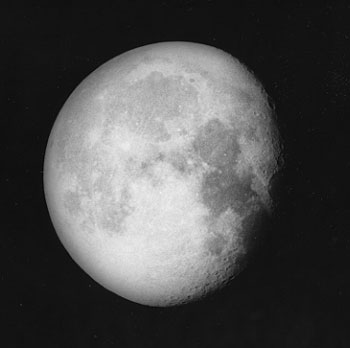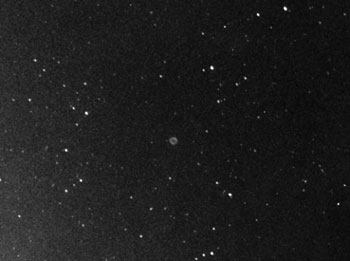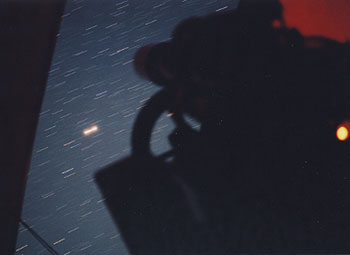
| Return |
| • July 25 We were still in the rainy season, but it was clear tonight too. I didn't go to the observatory and enjoyed star-watching from the rooftop of my home. I could see stars of up to 4.5 magnitude. The Milky Way around Sagittarius was barely visible. The highlight of the night sky these days is Mars, which rises late at night. The red glow of Mars at 2 am was awesome. People in ancient times looked at Mars in deserts and highlands and might have found its glow mysterious and even haunting, I imagined. The photograph shows Mars rising above Mt. Hitsuzan(*1) near Kagamigawa River. *1 Minor planet 7235 is designated Hitsuzan. |
 Mars over Mt. Hitsuzan Leica R4 50mm F2 4-minute exposure on ISO 400 film |
| • July 24 The night was with drifting clouds, but the summer Milky Way, which I haven't seen for some time, was so beautiful that I thought would even purify people's mind when they looked at it. It's really summer time now. The photograph shows the Milky Way taken by Leica R4 with Summicron 50mm F2. |
 |
| • July 17 It has been clear since morning and thunderheads were seen bubbling high in the northern sky, indicative of the end of the rainy season. I visited Sakurababa, where an observatory was said to have been located, following a map drawn by Torahiko Terada, a famous scientist-essayist who had lived in Kochi in his formative years. Who in the world built this observatory? I found a public bathhouse at the site called Sakuranoyu run by the city, oblivious to the plight of the observatory. I heard that an amateur astronomer called Kenzo Masaki had devoted his time to popularize astronomy in prewar years. The observatory drawn on Torahiko's map could be his. Torahiko wrote" when I was looking into the eyepiece, a star passed the crosshairs in a fraction of a second." The observatory site was a stone's throw from Torahiko's home. Maybe he was at Masaki's observatory. The dormitory of a teachers college was situated at Sakurababa in prewar days. Mr. Keiichiro Okamura (an instructor at Geisei Observatory), who lived in the dormitory, says he has never seen such an observatory. It is a mysterious observatory. However, the summer clouds in the expanse of the sky seems to know something about the mystery of the observatory. I will tell you later how stunning the starry skies over Kochi City were in prewar days. I know how beautiful the night sky was on October 1, 1940, when Comet Okabayashi-Honda (C/1940 S1) was discovered. |
 Cumulonimbus, a sing of arrival of mid-summer |
| • July 16 Mid-summer hot weather has been continuing since the day of the Star Festival, July 7. I took a photograph of the moon rising over Mt. Hitsuzan in the southeast using a 500mm telephoto lens in the evening. I also shot M57 in Lyre using a small equatorial mount guiding by hand. These photographs were taken from the rooftop of my home at Kamimachi in Kochi City. The skies were darker than before perhaps because of efforts to save energy and stars to 3rd magnitude were visible However, 4th-magnitude stars were not easily seen partly because of moonlight. I am looking forward to the night skies from autumn to winter. |
 The moon taken from the rooftop of my home 500mm telephoto lens with a 1/1000 second exposure on Prest 1600 film.  M57 in Lyre using 90mm f/5 reflector with a 3-minute exposure on Prest 1600 film from the rooftop of my home. |
|
• July 9 In spite of rain forecast, it cleared up and a 5-day-old moon was shining brightly in the western sky. I left home at 22.00 and arrived at the observatory at midnight. The Milky Way was hazy just like the one in springtime and Vega's refreshingly blue light was striking. From the dome of the observatory Mars was seen rising with a mysterious, ever-brightening light. Outside the dome was heard an intense but minutely vibrating chirping of insects. Insects making such sound at this time of year may be crickets. They were just loud. I came across a "flightless" firefly in the grass a long time since the last encounter. It was a long slender larva of a moth, 1.5 cm in length. in length. Unlike the one I saw in April, its color was blue. It occasionally emitted a beautiful greenish color from the end of the abdomen, similar to the color of blades of grass. The two big shining eyes of the "master of Geisei's forests" were staring at me among the distant trees, perhaps disturbed by my movement. It never showed its true identity, but was quite accustomed to me. With Mars'impending closest approach,insects as well as beasts seemed unusually agitated. |
 Mars seen from inside of the dome  Rising Mars |
Copyright (C) 2003 Tsutomu Seki.